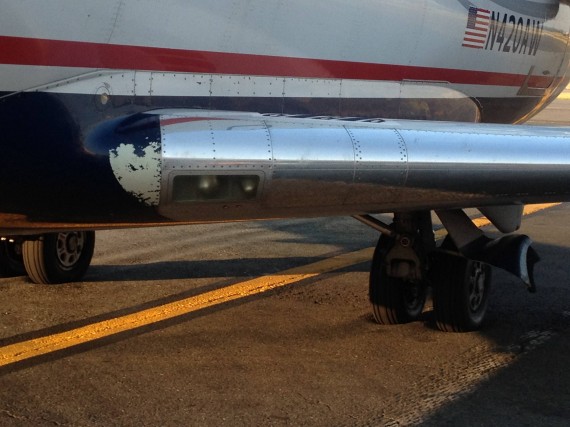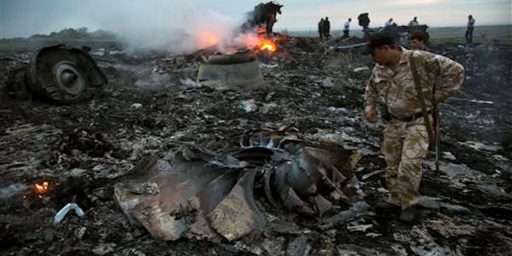D.C. Area Heat Causes Tarmac At National Airport To Soften, Trapping Plane
How hot was it in the D.C. area this weekend?
Things were proceeding normally Friday evening as a US Airways flight was leaving the gate at Reagan National Airport to begin its flight to Charleston, S.C.
But the temperature reached 100 degrees in Washington on Friday and that apparently softened the airport paving enough to immobilize the airplane. The small vehicle that usually tows planes away from the gate tugged and pulled,but the plane was stuck.
“It was apparently a soft spot caused by the heat,” airline spokeswoman Michelle Mohr said, and the airplane “wouldn’t move.”
A jet airliner getting stuck in the airport tarmac appeared to be one of the more unusual incidents that occurred in the Washington area amid a blistering string of daily temperatures above 95 degrees.
It was “pretty rare,” Mohr said. But then, she noted, “we’ve also had very unusual temperatures.”
The plane was eventually wrested loose only by the use of a larger tug after the passengers had been taken off the plane.
So, yea, it was hot.
Photo via Imgur







What’s odd about this is that it’s quite often over 100 degrees in DC–and other cities, notably Atlanta, Miami, Phoenix, etc.–that have major airports. It was over 100 degrees when I flew out of Reagan to Nashville last Saturday and over 100 degrees when I made the return flight yesterday. Yet, planes typically don’t get stuck in the tarmac goo.
So . . . something odd happened here that’s about more than simply being hot.
@James Joyner:
Inferior asphalt, not enuf compaction of the sub-strata, the wrong sub-strata…. My bet would be the first. It happens.
@James Joyner:
And what’s up with hardboiled eggs? Soft boiled eggs are put in water that’s just as hot but don’t get all solid like that.
@Stormy Dragon: But planes come and go on a fairly routine schedule. It’s not as if this one had been parked at the gate for several days or something.
@James Joyner:
My point was that it’s not just the amount of heat that makes asphalt soft, but how long the heat lasts. DC has days over 100, but usually doesn’t have long stretches of it like they’ve been having.
Why didn’t they use the jet engines to power them out?
@Tano:
They were probably trying to back away from the gates, which is normally done with a tug because reverse thrusting at low speeds risks blowing foreign objects into the engine intakes.
@Stormy Dragon: It’s unusual, especially for so early in the season, but hardly unprecedented. And it’s even more common in Atlanta, Phoenix, and other hotter cities with major airports.
@James Joyner:
Which was no doubt taken into account when choosing what sort of asphalt to use. The fact that runways at airports that are warm year round are performing better in a heat wave thanthe runways at an airport that has to deal with both summer and winter extremes is hardly suprising.
Back in the “day” that would not have happened because the parking aprons would have been made of concrete with a bed of about 3 ft of packed gravel over a couple ft of compacted earth.
Asphalt MELTS and softens… we had a contractor come out and do some work and we now have a big divot in the asphalt drive way from the truck that parked there.
@James Joyner:
There’s no standard to designing an airport. If your surfaces are concrete then this won’t happen. If they are asphalt then it will.
@Stormy Dragon:
Just like around this time in DC in 2002. Multiple days over 100F (I was moving between storage units and remember it well $180/mo versus $50/mo).
Friends of mine have a pavilion off the GW Parkway for Capitol 4th. About one year out of 4 doesn’t end in a thunderstorm.
Now, the wall cloud (drencho?) was a bit unusual for how big it was.
Heh, pretty amusing.
Asphalt by itself is really a liquid with very high viscosity, and of course temperature affects the viscosity of most liquids. What is actually used for roads and runways is mixed with aggregate and would more correctly be called “asphalt concrete”, where the asphalt is the glue that holds it together.
As others have mentioned, there are different grades and presumably the runway pavers would choose one appropriate to the airport’s expected temperature range. Like any engineering choice, they had to balance various factors including cost.
Luckily, this just happened while a plane was parked, rather than a wheel “digging in” to the tarmac upon landing, which can potentially result in some large spikes of load.